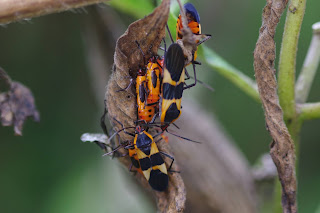Today's bug walk was different from yesterday's in almost every respect, by almost all metrics. There were, however, two similar incidents. One you will see in arachnid appreciation. The other you will see... well, before that. But first, Backyard Bug of the Day:
Hard to see, isn't it? This is a caterpillar that has cut two oval discs out of a leaf and stitched them together with silk thread. It is now using more silk to attach it to the bark of a tree, and will pupate inside its little leaf envelope. This time of year I sometimes find these dangling from trees. Later I will find them stuck to tree trunks as this one is working on. It's not in my caterpillar book, and though someone told me years ago what this will become, all I remember is that it will be a tiny moth. This is less than 1/16th of an inch long.
Closer look
Here's a better view of what the case looks like.
Now for a callback to yesterday:
You may think you have seen this moth before, if you read yesterday's blog, but this is not the same species of moth as yesterday's Backyard Bug of the Day. I thought it was at first, when it flitted past me and landed on a leaf right at my eye level, where I could get a good look at it. Having tried so hard to identify yesterday's moth, though, I was quickly able to distinguish the characteristics that make this one different. I was going to point them out to you, but maybe you should stare at this one for a while, noticing things like markings and wing shape, and then check out yesterday's blog yourself. I had to use the same process to identify this one, which I think is a Large Maple Spanworm Moth, another geometer, aka inchworm.
Other Bugs:
There are fewer large milkweed bugs now. I wonder if some of them have flown away, now that they have wings. This shot reminds of of a 1980s album cover for some reason.
The white thing sticking out from the side of this leaf is the exuvia shed by one of these new adults. I am surprised not to have seen more of them, as quite a few molts have happened in the last two days. And, in fact, with all of these insects having multiple molts as they grow, there should be rather a lot of exuviae around.
Assassin bug nymph on purple coneflower
It was tricky getting a shot of this moth on goldenrod. It was feeding very aggressively.
Caterpillar on the decaying stalk of a common mullein plant:
Once again, not in my book. It's frustrating to want to know what things are an be unable to find out.
Beetle
Arachnid Appreciation:
.
.
.
.
.
.
.
.
.
.
.
.
Once again I found a flower crab spider on a thistle, but today, unlike yesterday, the spider seemed to be completely alone on the plant, with no bees or other insects feeding on the flowers. I had a hard time getting pictures, because it was breezy and the flowers bob up and down in the wind, and you can't exactly hold onto a thistle flower to steady it. Just as I took this picture, though, a bee showed up–it is that blur on the lower right.
The spider didn't seem to notice the bee, and it flew away immediately, but I then saw the spider react to something coming its way...
To my surprise, and I think the spider's the ant crawled right over it! I don't know why the spider did not grab it, but ants do have a defense against predators, being able to spray them with formic acid, so I suppose it's possible the spider knew that.
Alone again.





















No comments:
Post a Comment